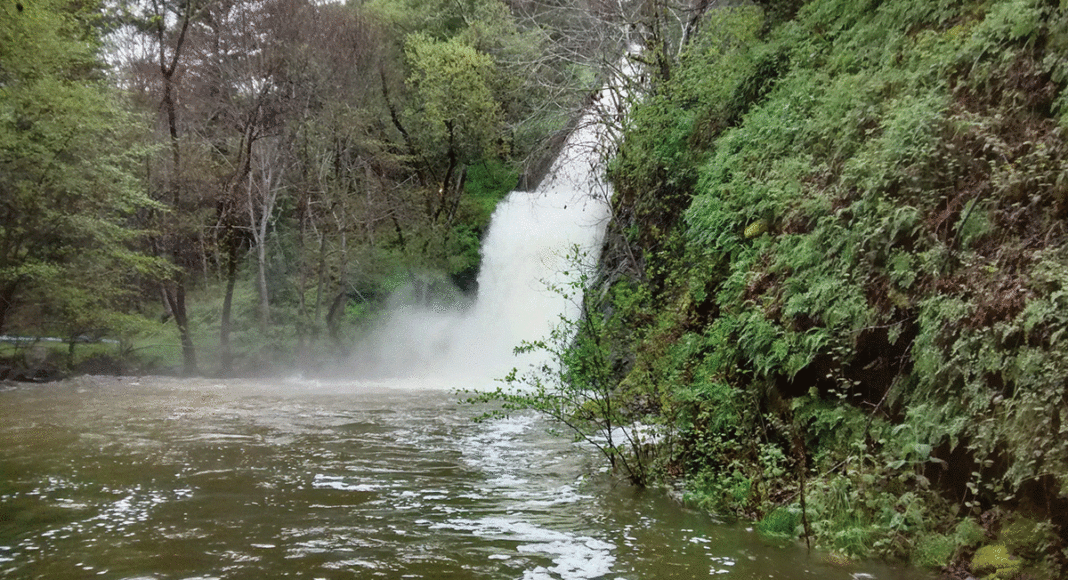Even before an atmospheric river tore into the area last weekend, knocking down trees and ripping up hillsides in the Santa Cruz Mountains, the city’s water department had hit its eagerly anticipated winter benchmark. The Loch Lomond Reservoir reached full capacity, teeming with water, which spilled over the narrow manmade lake’s earthen dam and into Newell Creek, 190 feet below, at around 5 a.m. on Jan. 5.
But this news, although promising, can’t provide any sense of true water security for the city.
After all, the brimming supply at Loch Lomond—which filled up quickly this season—tells us less about the magnitude of these winter storms than it does about the modest capacity of the city’s water storage. The 2.8 billion gallons held there is roughly the same amount of water Santa Cruzans drink each year. And although the 96,000 customers it supplies draw from other sources when they turn on the tap—the San Lorenzo River, North County streams and a few local wells—the lake is still a major source, providing the city with about a quarter of its water, not to mention its emergency supply in major shortages.
But as of Monday, Jan. 9 it happens to be the city’s short-term water supply that’s running a little low—thanks, ironically, to all this rain.
In the days that followed the reservoir’s spill, a rainy storm—which ravaged the Lompico and Boulder Creek areas, shutting down Highway 17 with mudslides—damaged the Newell Creek Pipeline, prompting water department spokesperson Eileen Cross to ask customers to cut back their usage by 30 percent through Monday, Jan. 16.
Elsewhere in the state, a slowly weakening five-year drought is still a major problem, most notably in Central and Southern California, according to National and Oceanic Atmospheric Association (NOAA). But here in Santa Cruz, the drought is just about over, recent data shows. Drought conditions have persisted longer in the county’s southern reaches, including the Pajaro Valley, although the weekend’s intense rain probably changed that.
Regardless, the drought was never the real root of the county’s water anxiety, which stems instead from decades of over-pumping aquifers and the resulting seawater intrusion seeping into the county’s wells, coupled with inadequate water storage. The drought simply made matters more serious.
Ron Duncan, general manager for Soquel Creek Water District, says every year that Loch Lomond fills up (which, historically has happened seven out of 10 years), his customers start asking him if their water shortage is over. This year, one customer even sent him a picture of the spillover, as if all Duncan needed was photographic proof in order to be convinced that it was time to lighten up and let people spend a few extra minutes in the shower.
“It’s natural for people to think when it rains, all our water problems go away,” says Duncan, who’s been managing the infamously overdrafted district for the past year and working on possible regional solutions with the city, too. “They see the creek, and it’s flowing. They believe what they see. It’s what we don’t see that tells the story here.”
Three quarters of county residents—pretty much everyone outside the city’s water district—rely mostly on groundwater for their drinking water. It’s a precious commodity that’s fleeting, and at a faster rate along the coast, where seawater seeps into drying basins and contaminates them.
Brian Lockwood, interim general manager for Pajaro Valley Water Management Agency (PVWMA), says it can be difficult for engineers to know what water levels are like beneath their customers’ feet and just how bad seawater intrusion has gotten in certain areas.
“We are grateful for the rain, and we are closely monitoring the situation. The rain is allowing water levels to rebound,” Lockwood says. “But in a basin like ours that has been overdrafted for decades, this isn’t going to solve our problem.”
To do that, the PVWMA has tried getting innovative, and has begun doing a bit of everything.
For the last few years, UCSC grad students, led by hydrologist Andy Fisher, have developed methods of diverting runoff agricultural water into basins to recharge aquifers. The agency’s board approved a $4 million plan called the Drought Response Irrigation Program (DRIP) last year to divert 240 million gallons of blended recycled water for agriculture. The board has additionally approved a plan incentivizing residents to install percolating systems on their properties, also to help recharge the aquifer down below. On top of that, it’s considering a plan called FLIP—which stands for Fallow Land Incentive Program—to encourage farmers to let their farm plots sit idly, allowing water to soak deep into the earth.
And while the board also contemplates three ambitious long-term projects—which would combine for $68 million if done all together—the groundwater seems to already be responding, Lockwood says. Historically, water levels at wells have dropped a median of 1.5 feet per year. Last year, they were up 1.6 feet, although he acknowledges it’s still much too early to celebrate.
Farther away from the coast, other water districts aren’t ready to loosen their belts, either.
Even in San Lorenzo Valley Water District (SLVWD), ground zero for heavy rain, residents of Felton, Lompico and Boulder Creek area remain under stage 2 water restrictions. SLVWD gets its water from a combination of streams and wells, which generally take a long time to become replenished—especially because much of it runs off—no matter how the big winter storms are.
And once the water that does seep in starts trickling down, the recharge is difficult to measure and estimate.
“Water in major rivers can travel miles at a time. Groundwater migrates very slowly in the subsurface,” Lockwood says. “Groundwater inside clay can go inches per day. Groundwater inside dirt or sand can move feet per day, but certainly not miles. So, it takes a while to feel impact in the monitoring wells.”













